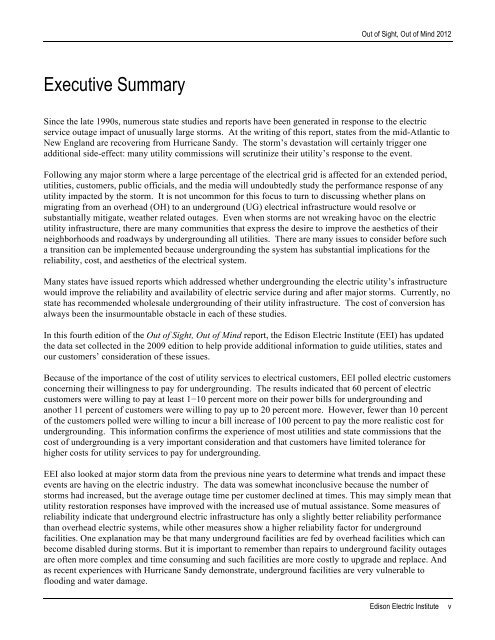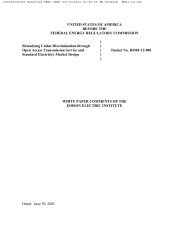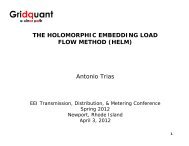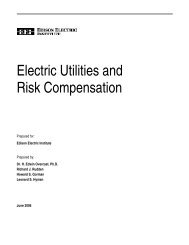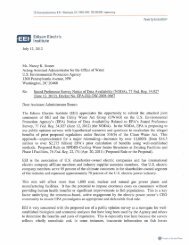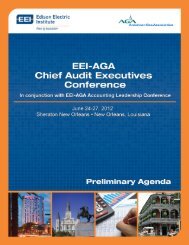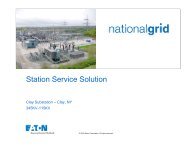Survey Questions - Edison Electric Institute
Survey Questions - Edison Electric Institute
Survey Questions - Edison Electric Institute
You also want an ePaper? Increase the reach of your titles
YUMPU automatically turns print PDFs into web optimized ePapers that Google loves.
Executive Summary<br />
Out of Sight, Out of Mind 2012<br />
Since the late 1990s, numerous state studies and reports have been generated in response to the electric<br />
service outage impact of unusually large storms. At the writing of this report, states from the mid-Atlantic to<br />
New England are recovering from Hurricane Sandy. The storm’s devastation will certainly trigger one<br />
additional side-effect: many utility commissions will scrutinize their utility’s response to the event.<br />
Following any major storm where a large percentage of the electrical grid is affected for an extended period,<br />
utilities, customers, public officials, and the media will undoubtedly study the performance response of any<br />
utility impacted by the storm. It is not uncommon for this focus to turn to discussing whether plans on<br />
migrating from an overhead (OH) to an underground (UG) electrical infrastructure would resolve or<br />
substantially mitigate, weather related outages. Even when storms are not wreaking havoc on the electric<br />
utility infrastructure, there are many communities that express the desire to improve the aesthetics of their<br />
neighborhoods and roadways by undergrounding all utilities. There are many issues to consider before such<br />
a transition can be implemented because undergrounding the system has substantial implications for the<br />
reliability, cost, and aesthetics of the electrical system.<br />
Many states have issued reports which addressed whether undergrounding the electric utility’s infrastructure<br />
would improve the reliability and availability of electric service during and after major storms. Currently, no<br />
state has recommended wholesale undergrounding of their utility infrastructure. The cost of conversion has<br />
always been the insurmountable obstacle in each of these studies.<br />
In this fourth edition of the Out of Sight, Out of Mind report, the <strong>Edison</strong> <strong>Electric</strong> <strong>Institute</strong> (EEI) has updated<br />
the data set collected in the 2009 edition to help provide additional information to guide utilities, states and<br />
our customers’ consideration of these issues.<br />
Because of the importance of the cost of utility services to electrical customers, EEI polled electric customers<br />
concerning their willingness to pay for undergrounding. The results indicated that 60 percent of electric<br />
customers were willing to pay at least 1−10 percent more on their power bills for undergrounding and<br />
another 11 percent of customers were willing to pay up to 20 percent more. However, fewer than 10 percent<br />
of the customers polled were willing to incur a bill increase of 100 percent to pay the more realistic cost for<br />
undergrounding. This information confirms the experience of most utilities and state commissions that the<br />
cost of undergrounding is a very important consideration and that customers have limited tolerance for<br />
higher costs for utility services to pay for undergrounding.<br />
EEI also looked at major storm data from the previous nine years to determine what trends and impact these<br />
events are having on the electric industry. The data was somewhat inconclusive because the number of<br />
storms had increased, but the average outage time per customer declined at times. This may simply mean that<br />
utility restoration responses have improved with the increased use of mutual assistance. Some measures of<br />
reliability indicate that underground electric infrastructure has only a slightly better reliability performance<br />
than overhead electric systems, while other measures show a higher reliability factor for underground<br />
facilities. One explanation may be that many underground facilities are fed by overhead facilities which can<br />
become disabled during storms. But it is important to remember than repairs to underground facility outages<br />
are often more complex and time consuming and such facilities are more costly to upgrade and replace. And<br />
as recent experiences with Hurricane Sandy demonstrate, underground facilities are very vulnerable to<br />
flooding and water damage.<br />
<strong>Edison</strong> <strong>Electric</strong> <strong>Institute</strong> v


